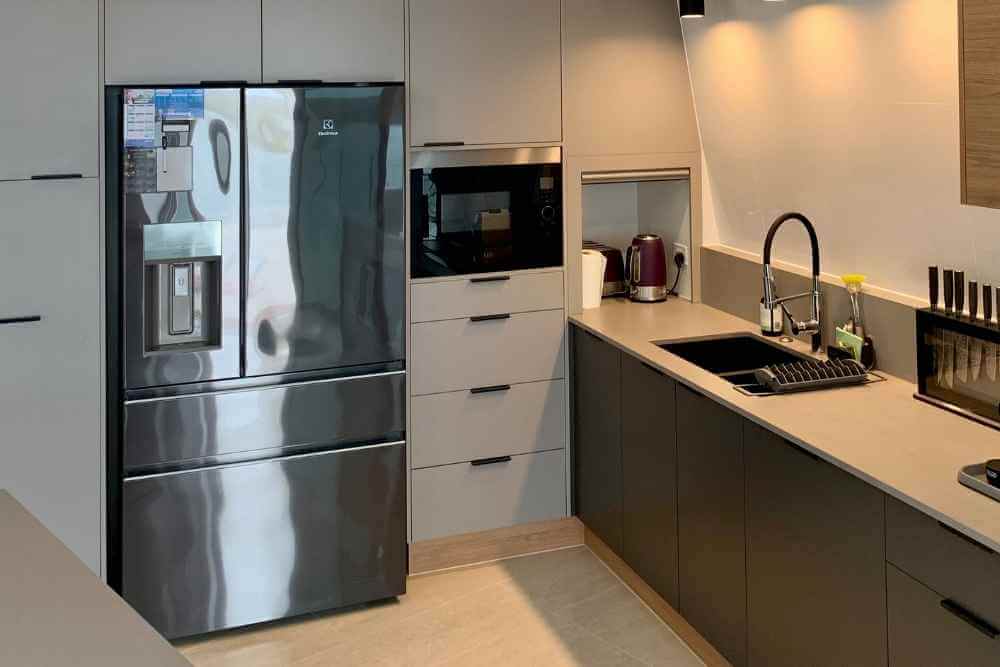Keeping your refrigerator sparkling clean is a key part of a good kitchen cleaning routine! (Ha, that rhymed.)
Food stains, spilled drinks, and other debris can build up on interior surfaces over time. Meanwhile, forgotten leftovers can go stale or spoil where they’re hiding at the back. And who doesn’t have an unfinished bottle of sauce from dinner… last month?
All of these can lead to messy surfaces, unpleasant odours, and even mould or bacteria. A dirty fridge is a health hazard, and could even malfunction or break down.
Routine fridge cleaning involves wiping exterior surfaces and checking for any food messes inside. For a deeper clean, you’ll need to empty the fridge to tackle all the surfaces.
A clean, organised fridge keeps your food safe and hygienic. (And makes it easier to hide your Friday night treats, too!)
Routine Cleaning | Before Deep Cleaning | Cleaning Inside the Fridge | Cleaning Outside the Fridge | Cleaning a Mouldy Fridge | Maintenance Tips
How Often to Clean the Refrigerator
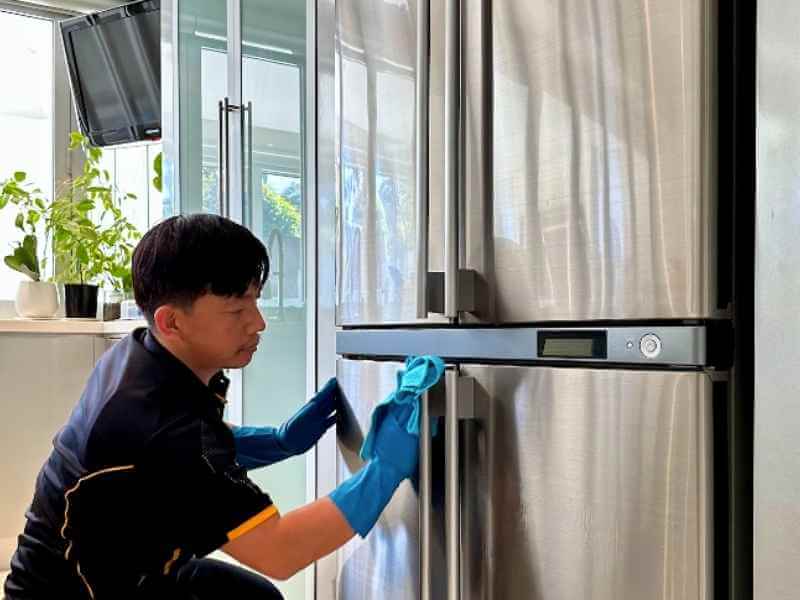
Deep clean your fridge every 3–4 months, inside and out! This helps keep it in good working condition — and lets you toss out any spoiled or stale food.
Don’t forget to clean the freezer as well.
If your refrigerator has a built-in water or ice dispenser, empty and wash the drip tray every few days. Then clean the dispenser every 3–6 months.
Spot-clean the refrigerator at least once a week by wiping the handles and any smudges on the surface. Check for any messes inside as well.
And of course, tackle any food spills immediately.
Feeling daunted by the task of tidying up all those shelves and containers full of leftovers? Tack on a professional fridge cleaning when you book a flat rate service with Maid2Match.
Routine Fridge Cleaning
At least once a week — or throughout the week — lightly clean the refrigerator.
Use an all-purpose cleaner and a microfiber cloth to wipe the handles and exterior surfaces. For stubborn stains, scrub them off with a soft brush or a little baking soda paste.
Do a quick inspection inside the refrigerator for any spoiled food, open bottles, and other messes.
Wipe lids, covers, and other surfaces with a paper towel. And toss out any leftovers that have gone off!
Before Deep Cleaning the Refrigerator
Every few months, you’ll need to get into all the corners of your fridge for a deeper clean!
This will be one of the bigger tasks when it comes to kitchen cleaning, so set aside an hour or two and pick your favourite playlist. Gather all your supplies beforehand.
Open the windows or fans so you’re working in a well-ventilated space, and wear rubber gloves.
Prepare the refrigerator for cleaning
Before you start, make sure you have the proper storage for your food!
Keep perishable items (such as meats and dairy) cool in an esky. They cannot sit at room temperature for more than 2 hours.
Switch off the refrigerator and unplug it, then carefully move it away from the wall. Clear out the shelves and drawers inside — you want to empty all the contents.
While you’re doing this, take an inventory and check for items that are spoiled, expired, or stale. Group items that go on the same shelves so you can reorganise them later on.
(And hey, no one will know if you treat yourself to a snack or two.)
Take out all removable shelves, trays, and drawers, then set them aside in the sink.
What to use to clean a fridge
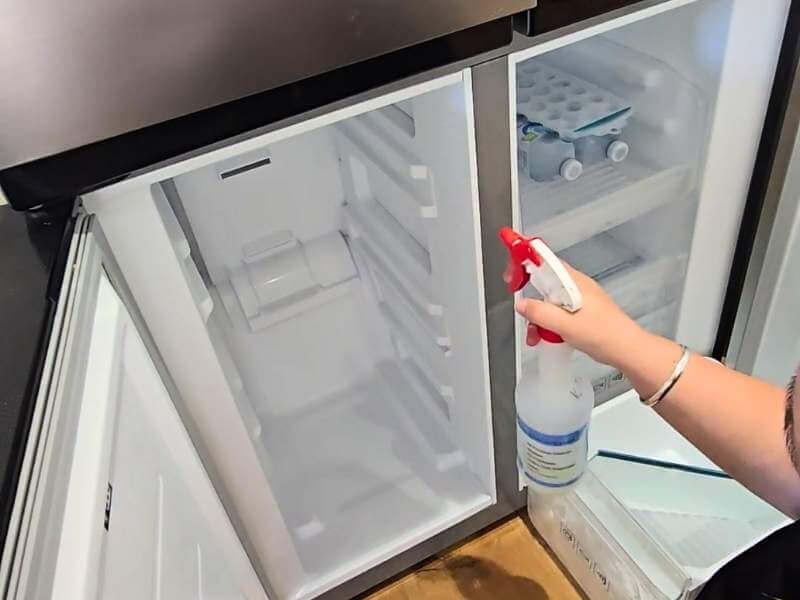
You don’t need much to deep clean a refrigerator — a good multi-purpose cleaner will do the trick!
If you’d prefer a natural fridge cleaner, though, some food-safe options include:
- Dish soap and hot water
- Lemon juice and warm water
- White vinegar and warm water
Mix equal parts water and lemon juice or vinegar in a spray bottle. For the dish soap, add a good squirt into a bowl of water.
Alongside your chosen cleaning solution, you’ll need a non-abrasive sponge, microfiber cloths, and an old toothbrush. Break out the vacuum cleaner and crevice attachment, too.
If there’s any raw meat contamination in your fridge or freezer, disinfect the surfaces with hydrogen peroxide or diluted oxygen bleach.
What should you not clean a fridge with?
Avoid harsh cleaners that contain things like bleach or ammonia unless necessary. These can damage the fridge material or leave a harmful residue.
Skip too-abrasive cleaners like steel wool, which can leave scratches or scuff marks on the interior surfaces. Bacteria, moisture, or mould spores can get trapped there and lead to hygiene concerns.
How to Clean the Inside of Your Fridge
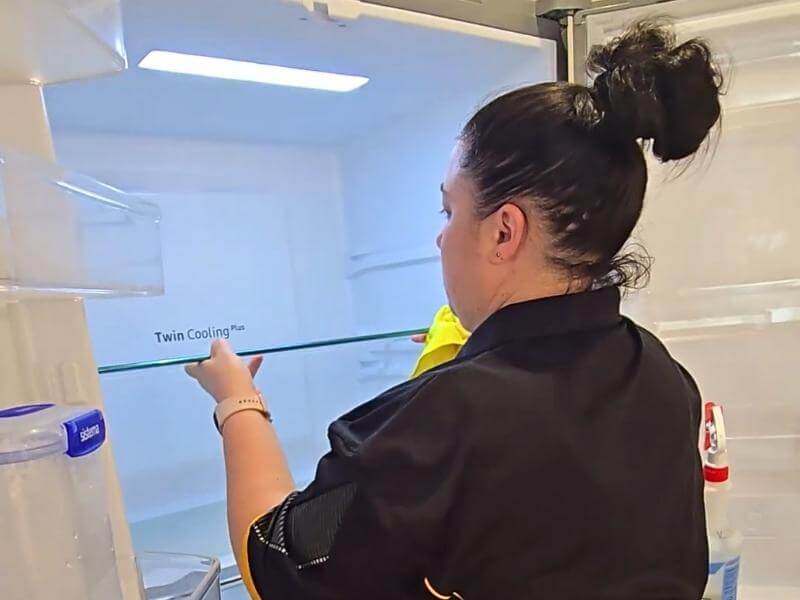
When deep cleaning inside the refrigerator, start with the topmost surfaces and work your way downwards. This way, dirty won’t get onto already-clean spots.
Be efficient but be thorough. The food shouldn’t be out of the fridge too long (especially in the summer), but it’s important to get every surface sparkling.
You can follow the same instructions to deep clean your freezer!
Interior surfaces
Hoover up any loose debris with your vacuum’s crevice attachment. Get into all the corners, especially inside drawers.
Spray the interior of your fridge with your chosen cleaner. Leave the cleaner to work its magic for a few minutes before going over the surfaces with a clean cloth.
If you chose to go with hot, soapy water, dip a soft cloth in the solution and use it to wipe the surfaces clean.
For any stains or stuck-on food, make a cleaning paste with some baking soda and warm water. Apply the paste with a damp sponge and scrub the stain off.
Dry the inside of your fridge, then leave it open for a while to air out any odours. (Especially if you cleaned with vinegar!)
Shelves and drawers
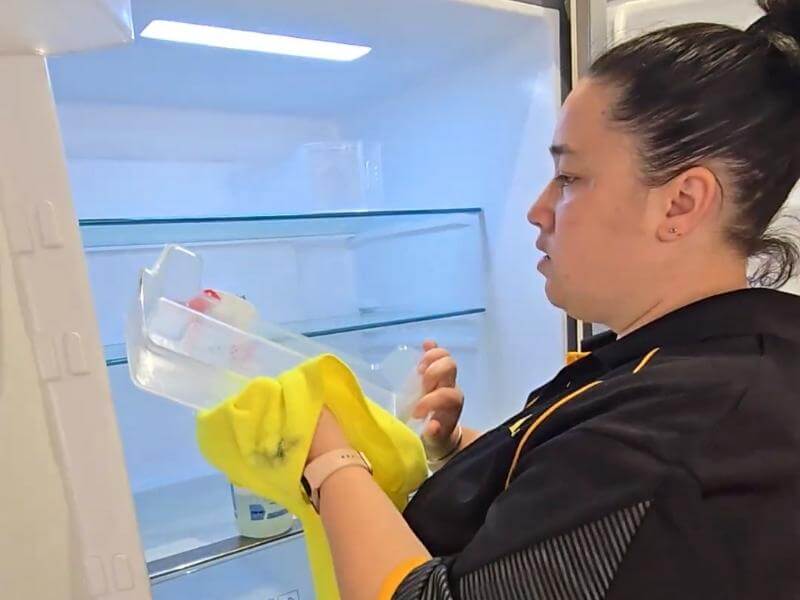
Before you clean the fridge shelves and drawers, make sure they warm up to room temperature. Otherwise, the glass or plastic might crack!
While your fridge is airing out, wash the shelves, drawers, and trays with hot water and dish soap. Rinse them thoroughly, then dry them with a clean cloth.
If you’re feeling a bit lazy, though, you can absolutely clean the trays and drawers by spraying on some white vinegar and wiping them.
Avoid using an all-purpose cleaner on clear trays or drawers unless specified by the manufacturer. These products can leave streaks or marks on clear glass and plastic.
Seals or gaskets
For fridge seals or gaskets, stick to warm water and dish soap. Prolonged or repeated exposure to vinegar can dry out rubber seals and degrade the material.
To clean fridge seals, scrub them with soapy water and an old toothbrush. Get between the folds where dirt can accumulate, too!
Use a damp cloth to wipe off any residue. Then ensure the seal is completely dry to prevent mould or mildew growth.
How to Clean the Outside of A Fridge

Once you’ve tackled the interior, it’s time to deep clean the fridge exterior!
Don’t just focus on the front of the fridge — we often overlook the top and back surfaces, since we can’t see them. But dust accumulates there over time, too, so they still need some TLC.
Cleaning the fridge exterior
To clean the outside surfaces of your refrigerator, you can use one of the following:
- Diluted white vinegar
- All-purpose cleaner
- Hot water and dish soap
Apply your chosen cleaning solution with a microfiber cloth, then wipe the surfaces clean. Scrub off any stains with a sponge or soft-bristled brush.
Alternatively, apply some baking soda paste with a sponge and let it sit for a few minutes. Gently scrub the stain off before wiping away any residue with a damp cloth.
Pay extra attention to the handles, and don’t forget the back of the fridge, too!
Cleaning the water dispenser
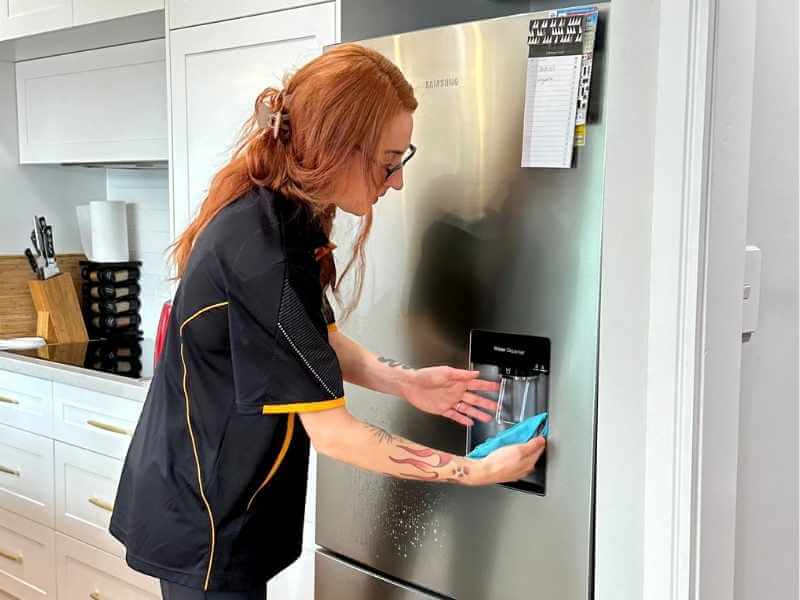
Check your owner’s manual for instructions on how to clean the refrigerator water dispenser. That way, you can properly disconnect the water line and locate the shut-off valve without voiding your warranty.
In general, you’ll need to flush the water line and clean the reservoir. Your fridge manufacturer may have a recommended cleaner, or you can use white vinegar.
Flush the dispenser system with clean water a few times to remove any vinegar taste or scent.
Cleaning the area around the fridge
While you’ve got the refrigerator out, take the time to clean the space behind it.
Grab your vacuum cleaner or broom and remove any dust, debris, and other dirt from the floor. Use a microfiber cloth or soft duster on the walls.
You can also use a duster or a specialised coil brush to clean around the refrigerator coils. If your vac has a crevice attachment, use that to get into any hard-to-reach spaces.
Check if there’s a removable tray or grate near the bottom — you can remove any dust or dirt with a microfibre cloth.
Quickly mop the floor, then wipe the walls with some all-purpose cleaner. Let everything dry before plugging the fridge and moving it back to its rightful place.
How to Clean a Mouldy Fridge
Excess moisture, spoiled food, or a mechanical issue can lead to mould growing in your fridge. That becomes a health hazard you must tackle immediately — otherwise, it could contaminate other items.
When cleaning a mouldy refrigerator, work in a well-ventilated space and wear a secure face mask to minimise the risk of inhaling spores. Use rubber gloves as well.
Start by emptying the fridge and inspecting all the contents. Toss out anything with mould.
Using white vinegar
Distilled white vinegar (or even cleaning vinegar) can kill mould, but it needs to sit for at least an hour to be fully effective.
Start by removing all the shelves and drawers from the fridge for easier access. Then pour some undiluted white vinegar into a spray bottle.
Thoroughly saturate all the surfaces — including the shelves — with vinegar. Let the vinegar sit for at least an hour, then scrub the refrigerator clean with a soft cloth or sponge.
Reapply as necessary, then wipe dry. Wash the cloth or sponge in hot water afterwards.
Using peroxide toothpaste
Use this method if there are just small spots of mould or mildew on the rubber seals. Be sure to use white, non-gel toothpaste with peroxide as an ingredient.
Scrub the mouldy spot with the toothpaste and an old toothbrush. Leave for at least 10 minutes, then wipe off any residue with a damp microfiber cloth.
Repeat if necessary, then make sure the seals are completely dry.
Using hydrogen peroxide
3% hydrogen peroxide is effective for killing mould on non-porous surfaces, such as those in your fridge!
Do not combine it with anything, especially not vinegar. That creates a toxic reaction which can be dangerous to your health.
Pour undiluted 3% peroxide into a spray bottle, then completely saturate the mouldy surface.
Let the peroxide sit for at least 10 minutes before scrubbing off the mould with a soft-bristled brush. Reapply peroxide as necessary.
Dry the surface afterwards, then clean the rest of the fridge with hot water and soap.
Tips to Maintain a Clean Refrigerator
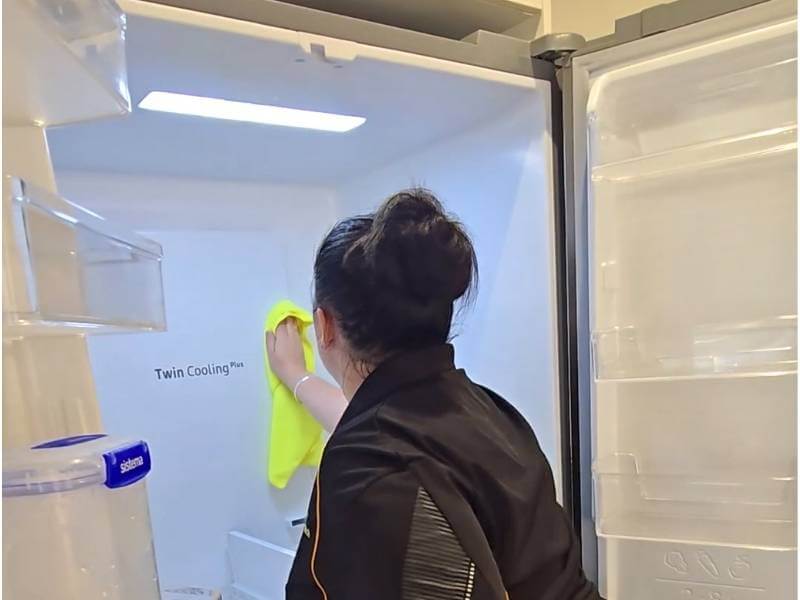
Proper maintenance will always be important, but there are ways to keep your refrigerator fresh and tidy in between cleaning sessions!
Store leftover food and drinks properly. Use airtight containers whenever possible, and make sure the lids or caps are fully shut.
Wipe any spills or messes immediately — they’ll be harder to clean up the longer they sit. This also prevents bacteria or mould from growing.
Keep an eye on the items in your fridge, especially fresh produce. This way, you can toss out anything that’s stale or going bad.
Don’t fill up your refrigerator! An overcrowded fridge has reduced airflow and energy efficiency, so it may not cool down properly.
If your fridge can’t maintain the correct temperatures (0º–5ºC), the food can spoil or become contaminated. It’s also harder to track the contents, so you might overlook a mess.
Regularly cleaning your fridge can help it work better and last longer — and keep your food safe.
Fridge Cleaning FAQs
Here are a few common questions or concerns people have about refrigerator cleaning.
What is the best thing to clean the inside of a fridge with?
You can clean inside the fridge with a safe all-purpose cleaner!
Other food-safe options include white vinegar or dish soap and warm water.
How can I clean a smelly fridge?
Spoiled food or drinks (like milk) can leave you with a smelly fridge — and that stink can seep into other items. You want to tackle any foul odours in your refrigerator ASAP.
To clean a fridge that smells, start by identifying the source and tossing it out immediately. Check other nearby items, too.
Thoroughly clean the inside of the refrigerator with lemon juice, white vinegar, or hydrogen peroxide. Leave the door open for 20–30 minutes afterwards to air out the smells.
If the odour lingers in the refrigerator after a few hours, you can place a small open container of coffee grounds or dry baking soda inside.
Leave the container for at least 24 hours so the odours are neutralised or absorbed.
How to clean a stainless steel fridge
For a stainless steel fridge exterior, you can use a dedicated stainless cleaner.
Follow the product instructions and be sure to wipe with the grain so you don’t leave smudges. Dry the stainless steel surface immediately to prevent spotting.
To remove stubborn marks, spray a little rubbing alcohol then wipe dry.
Can I use bleach to clean my refrigerator?
It’s generally not recommended to use bleach or a bleach-based product when cleaning the refrigerator. Bleach can damage the surfaces such as plastic or rubber gaskets.
You can use a bleach product to clean your fridge if absolutely necessary, such as raw meat spills or severe cases of mould.
Look for products with oxygen bleach, which evaporates quickly and is less harsh than chlorine.
Follow the product instructions for dilution and do not mix it with anything except water. Thoroughly rinse and wipe the surfaces afterwards to ensure there is no residue.

